Zermatt and its’ Matterhorn Ski Paradise is Switzerland’s most famous ski resort, and justifiably so. Zermatt is home to the highest ski resort in the Alps, has 360 kilometers of pistes linked across two countries, offers year-round skiing and the world’s most photogenic mountain towers above it all. Zermatt is winter should undoubtedly be on any skier’s bucket list.
But Zermatt isn’t only a dream for skiers and snowboarders. With an abundance of winter hiking trails, unique experiences from sleeping in an igloo under the Matterhorn to a progressive dining tour through some of the best restaurants in Zermatt, and world-class spas, there’s plenty to do in Zermatt for non-skiers. Zermatt is even a fantastic destination to bring along your furry family members with a plethora of dog-friendly attractions and activities.
Between outstanding alpine scenery and a magnetic atmosphere and old world charm, Zermatt is undisputedly the jewel in Switzerland’s crown. It’s why I couldn’t resist the lure of Zermatt in winter, and have visited the charming alpine village multiple times. When it comes to considering how many days in Zermatt, I think a 3-day Zermatt itinerary is just perfect. Make the most of your holiday in one of the world’s best ski resorts and discover all the best things to do in Zermatt in winter with my itinerary.
Day One: Explore the Village of Zermatt and Iglu Dorf
Zermatt is a car-free village and the only way to arrive is via train or helicopter, so part of your first day is the journey through the mountains just getting to Zermatt. Geneva is a gateway for skiers arriving to Switzerland, and the closest major airport. Geneva to Zermatt trains can carry Zermatt bound passengers to the alpine village in 3.5 hours. Since the village is car-free, horse drawn carriages and little electric taxis await outside the railway station to whisk new arrivals and luggage off to their hotels.
The village of Zermatt is an idyllic place to wander around and even though you’ve come for the world-class skiing, there will be time for that later. Skiing is always best in the morning when the pistes are freshly groomed, so take advantage of your mid-day arrival to first explore the village.
Walking Tour of the Village of Zermatt
Zermatt is nestled in a deep valley and surrounded by some of Switzerland’s highest mountains. The tall pyramid-shaped Matterhorn stands silent watch over the village below, made famous after seven British climbers first ascended the deadly mountain in 1865.
Just 40 years ago, transport in Zermatt was almost exclusively by horse drawn carriages. And there are plenty of horse carriages waiting to take visitors around the village. Or stretch your legs after the journey for a walk around.
The main street, simply known as Main Street, is a great place to begin your walking tour of Zermatt. It runs through the village and is lined with restaurants, bakeries and shops to pop in and out of.
Be sure to visit the part of the village known as the Old Town. Here you’ll find old farm buildings built of logs called Gädini, the oldest surviving in the village center. Some of the buildings are over 300 years old.
Their sun-beaten wooden walls are made of larch wood and stand on stilts with round stone slabs on top to prevent rodents and insects from entering. The roofs of these typically Valais-style buildings are covered with shingles made of flat stone slabs.
People would live on the top level and their sheep, pigs and cows lived in the barn beneath the house. The heat from the livestock would rise, making the top level a nice, cozy home.
Sadly, many of the Gädini fell into decline around the 1960s and their cultural heritage and value was not realized until many years later. Restoration projects have seen the outsides of the Gädini preserved in the traditional style and the insides have been modernized and converted into chic pubs and even holiday apartment rentals.
Stroll by the Monte Rosa, Zermatt’s oldest hotel before also checking out the church, and the fountain dedicated to Ulrich Inderbinen. Inderbinen was famous Swiss mountain guide who had ascended the Matterhorn over 370 times and made his last ascent when he was 90.
Visit the Matterhorn Museum
Zermatt is what it is today thanks largely in part to the Matterhorn. When it comes to attractions in Zermatt, the Matterhorn Museum – Zermatlantis is a must visit to learn more about the famous mountain’s history and the effect it had on the small farming village.
The Matterhorn Museum is a sunken underground world in the heart of Zermatt that instantly transports you back to the small agricultural village that was forever changed by the first ascent of the Matterhorn in 1865.
The Matterhorn was relatively unknown until the 1800s and was the last of the Alpine mountains to be ascended. But the rush of mountaineers to Switzerland’s most famous mountain would play an important role in developing Zermatt into the world-class mountaineering and ski resort it is today.
The museum is made up of fourteen small houses that include a church, hotel, huts and granaries. As you wander through the reconstructed village, the stories of the history and development of Zermatt unfold before you.
On July 14, 1865 a group of seven English climbers led by Edward Whymper were the first to successfully reach the summit by ascent of the Swiss side. Tragically upon the descent, four of the climbers: Robert Hadow, Michel Croz, Charles Hudson and Lord Francis Douglas, fell to their deaths on the Matterhorn Glacier. All but Douglas, whose body was never found, are buried in the Zermatt churchyard.
Edward Whymper wrote of the accident:
“As far as I know, at the moment of the accident no one was actually moving. I cannot speak with certainty, neither can the Taugwalders, because the two leading men were partially hidden from our sight by an intervening mass of rock. Poor Croz had laid aside his axe, and in order to give Mr. Hadow greater security was absolutely taking hold of his legs and putting his feet, one by one, into their proper positions. From the movements of their shoulders it is my belief that Croz, having done as I have said, was in the act of turning round to go down a step or two himself; at this moment Mr. Hadow slipped, fell on him, and knocked him over.”
The weight of the falling men dragged Hudson and Douglas down the face of the mountain. Whymper and the father and son Taugwalders were spared when the rope linking Douglas and the elder Taugwalder severed. You’ll gaze upon that very rope in the Matterhorn Museum…
Just three days after Whymper’s ascent, the Matterhorn was ascended from the Italian side via an indirect route by Jean-Antoine Carrel and Jean-Baptiste Bich on July 17, 1865.
As news of that tragic first ascent made its way round the world, mountaineers from far and wide rushed to the village to test their skills on one the of deadliest peaks in the Alps. The museum continues to tell the story of the evolution of mountaineering on the Matterhorn with relics from the earliest climbs on display.
The Matterhorn Museum is open differing times depending on the season. Check the opening times here.
Watch a Curling Match
It’s no secret that Zermatt is known as a world-class skiing destination, but did you know it also has a long history of curling? Curling actually traces its roots back to Scotland in the 1500s, and in the 1920s, Scotsmen had to pack those stones in their luggage and haul them all the way to Zermatt to be sure not to miss out on curling fun.
Since then, Zermatt has been the place for curling. Perhaps it’s because of the allure of the stunning setting with the Matterhorn standing watch over the village’s two curling rinks. The Curling Club Zermatt is the most successful curling club in Switzerland, and world-class curlers train on the ice in Zermatt. The Horu-Trophy, one of the largest and best open air curling tournaments in Europe, also takes place here with around 60 teams competing in it.
Basically two teams of four players each slide polished granite stones weighing between 38 – 44 pounds each across the curling sheet toward a target, called a house. Points are scored for the stones resting closest to the center of the house.
Two sweepers run along the ice and use their brooms to feverishly polish the ice so that the stone gains speed and slides further. The stone must touch at least the outer ring of the target in order to score any points. The players wear a special shoe, called a Teflon Slider shoe, on only one foot to help glide down the ice when delivering the stone.
A typical game lasts about 2 hours and is definitely a social sport.
There’s a tent selling glühwein, beer, sausages, and ironically, aspirin (for the hangover curlers are surely suffering the next day). Grab some sausages and a mug of glühwein, settle in at the picnic tables alongside teams taking a break, and enjoy the action.
Clutching our own steaming mugs of glühwein, we laughed and watched in fascination as 16 games unfolded before us. The players each strategize like they’re playing a game of chess on ice. The team of four would gather, pointing as they determined the best path for their stone to reach the house. One team member would launch the stone and then the sweepers were off, feverishly brushing the ice to keep the stone from “curling.”
If you’re keen to give curling a go, equipment rental is available from several shops in Zermatt such as Bayard Sport and Fashion, Glacier Sport or Julen-sport. You can also book a curling lesson with a guide and all the equipment, which ends with glühwein and a meal of cheese fondue, a traditional Wallis charcuterie plate and Swiss white wine from Wallis.
Ride the Gornergrat Bahn
In the late afternoon, make your way from Zermatt up to the Gornergrat at 3100 meters on the highest open-air cogwheel railway in Europe. It’s one of the best places to visit in Zermatt. And since you need a ticket on the Gornegrat Railway to access Iglu-Dorf Zermatt anyway, including a trip all the way to the top first for Matterhorn views is a no-brainer.
The 33-minute ride up to Gornegrat is a Zermatt sightseeing experience in and of itself. You’ll want to choose a seat on the right side of the train for the journey from Zermatt to Gornegrat for Matterhorn views. The train twists around curves of the mountainside as you climb, giving riders the most incredible views.
There are several stops along the train journey, and you can hop on and off at as many stops as you like. I recommend first taking the train all the way to the top at Gornergrat, then heading back down to the Rotenboden station for Iglu-Dorf Zermatt.
Spend a Night in the Most Unique Accommodation in Zermatt: Iglu-Dorf Zermatt
An unforgettable experience, you can sleep in artfully decorated igloos in a snow village that is re-constructed each winter under the watchful peak of the Matterhorn. As luxe an experience of quite literally sleeping in the snow can be, a night at Iglu-Dorf is undoubtedly one of the best things to do in Zermatt.
To reach Iglu-Dorf Zermatt, you need a ticket on the Gornegrat Railway. Though you can purchase a discounted ticket just to the Rotenboden station, where you meet the guides for the Iglu-Dorf adventure, I recommend first taking the cog wheel train to Gornergrat at the very top.
From the Rotenboden station, you make a short 15-minute trek to the Iglu-Dorf Zermatt igloo village. You’ll want to just pack a small backpack with essentials for your overnight stay in Iglu-Dorf.
After a briefing and run-down of the night’s events, our group excitedly hiked back up the steep hill and hopped back on the train to whisk us up even higher to 2727 meters (8947 feet). The wind swirled snowflakes around us as our group set off on another short downhill hike to Iglu-Dorf. An electric buzz went through our group as we were all welcomed into the snowy enclave with hot mulled wine and popcorn.
With eyes wide, we followed the guides through the long candle lit tunnels of the igloo village on a tour of the artfully crafted rooms, each one different from the next.
The common room has tables and hot water with a selection of teas always available to keep hydrated throughout the overnight stay. There were also fixings to make a noodle soup to snack on until dinner. The ice bar serves a variety of wine and drinks (at an additional charge). The igloo village also has two outdoor jacuzzi, and everyone got signed up for 30 minute time slots while chatting over snacks and drinks.
Soon a communal dinner of piping hot cheese fondue was served. Tim and I had our fill and our guides invited us to use the jacuzzi early. No way were we turning that offer down! We quickly stripped down and pulled on our bathing suits in the heated changing room. Having forgot to pack flip-flops, I sprinted down the snowy path to hop into the swirling hot water. The jacuzzi was sort of sheltered by a wall of snow, but the wind was picking up and it was an odd sensation to have most of our bodies toasty hot in the bubbling water yet feel an icy blast of tiny snow crystals on our backs and necks. We’d laugh as we both sort of cringed at unwelcome momentary blast of cold.
We actually both got quite hot and took turns taking pictures of each other as we had refreshing rolls in the snow, quickly hopping back in to the jacuzzi a few minutes later.
Soon it was time for bed and we stripped down to just one layer of long underwear and climbed into our -40F expedition sleeping bag for two. It’s recommended to sleep with a hat on since your head is partially exposed, but I was actually pretty toasty and just pulled the hood of the sleep bag up around my head.
Tip: Place your clothes for the next day inside your sleeping bag with you and they’ll be nice and warm for the morning.
Unfortunately, all that tea to stay hydrated had done its job and I had to race across the windy courtyard of the igloo village to the bathroom 3 times throughout the night. The wind was really blowing snow drifts around each time I got up, but Tim got lucky and found a calm, cloudless night when he had gone out. With no moon, it was too dark to spot the Matterhorn though.
Our wake-up call came with a serving of hot tea in bed and notice we’d be meeting to head back down to Hotel Riffleberg in 15 minutes. Unfortunately, it was still very cloudy so a view of the Matterhorn wasn’t in the cards. After a 20 minute hike downhill to the hotel, a hot breakfast spread of eggs, bacon, sausages, fruit, cheese, and bread awaited us. What a delicious way to end a chilly adventure at Iglu-Dorf.
Day Two: Explore Matterhorn Glacier Paradise
With more than 360 kilometers of marked slopes in the Matterhorn Ski Paradise, today’s the day to hit the slopes. Or, if like me, you’re not a skier, then head out to explore some of the best Zermatt attractions like Matterhorn Glacier Paradise before ending the afternoon at one Zermatt’s day spas.
Matterhorn Glacier Paradise
Located on the Klein Matterhorn, or Little Matterhorn as it translates in English, Matterhorn Glacier Paradise sits at 3883 meters (12,740 feet). The highest cable car in Europe whisks visitors up to Matterhorn Glacier Paradise, where you’ll find 360° of the Swiss Alps. The breathtaking views are undoubtedly why visiting Matterhorn Glacier Paradise is one of the best things to do in Zermatt.
Generally the mountains are clearest in the morning, so you’ll want to head up to Matterhorn Glacier Paradise first thing. Not only is the best time of day for the weather, it is also generally less crowded as skiers like to hit the slopes for the best snow conditions first thing.
There’s actually several routes you can take since it takes a series of cable cars to reach Matterhorn Glacier Paradise from Zermatt. No matter which route you choose, the first leg of the 45-minute journey takes you from Zermatt to Furi. Many visitors then transfer to the cable car to Schwarszee in Furi, since this is the most scenic route up offering unique Matterhorn views.
We even recommend you allow some time for a stop in Schwarzsee. Here you can walk the short distance from the cable car station to the popular Matterhorn photo spot with the Zermatt sign. Then can hop back on the cable car to Trockener Steg, and change to the cable car called Matterhorn Glacier Ride for the final ride up to the summit.
Once at the summit of Matterhorn Glacier Paradise, you can admire one of the best views in Switzerland. The viewing platform looks out over 38 mountain peaks and 14 glaciers across Switzerland, Italy, and France.
And don’t miss out on the ice sculptures in the Matterhorn Glacier Palace, located 15 meters below the surface and accessible via a lift. If you’ve been to Chamonix’s Mer de Glace, the Glacier Palace is similar to explore with both naturally formed ice shapes and sculptures created by artists each year. It’s a perfect place to spend some time taking unique photos.
There’s also a restaurant, where you can find international cuisine from burgers to pizza along with Swiss specialties like rösti.
Visit a Day Spa
After a day spent exploring Europe’s highest cable car station, you might want to spend some time relaxing with a little self-care at one of Zermatt’s day spas. Your hotel might have some spa facilities for guest use like a sauna or jacuzzi. There’s also a number of Zermatt hotels with fabulous spas that offer a day pass.
Head to CERVO Mountain Resort, which sits just a little above the village of Zermatt. It’s easily accessible via a lift. The hotel’s spectacular setting blends in to the surrounding nature, and offers magnificent Matterhorn views. Not only that, 90% of the CERVO’s energy is generated by geothermal and solar sources making it a sustainable choice.
You don’t have to be a guest of the hotel to enjoy it, either. CERVO Mountain Resort offers a day pass for their Mountain Ashram Spa. The day pass includes use of the spa facilities like the pools and saunas, scheduled activities like yoga and meditation in the ritual room and use of the climbing wall.
Where to Stay in Zermatt
For a relatively small village nestled in the Swiss Alps, Zermatt offers quite an array of accommodations. From boutique hotels in Zermatt offering Matterhorn views to ski chalets, the choice can almost seem overwhelming when choosing your accommodation. Many accommodations offer luxury amenities onsite including wellness centers and fine dining restaurants. We’ve stayed at several different places and can recommend these Zermatt hotels for your trip.
CERVO Mountain Resort
CERVO Mountain Resort is one of the best ski-in, ski-out hotels in Zermatt. Practically its own little village, CERVO Mountain Resort is perched on a hill overlooking Zermatt and with impressive Matterhorn views and considered one of the best places to stay in Zermatt. But despite its size, it is still a family-run boutique hotel.
There are just 36 rooms spread over seven different chalets on the property, which were all just renovated in 2020 and all are mountain facing with balconies. Entire chalets can be rented to accommodate a family or group trip.
There’s also the Mountain Ashram Spa, a sought after wellness center which does offer day passes for purchase to non-guests. And there are several onsite restaurants. CERVO Kitchen is one of those restaurants, and during the daytime it offers a ski-in outdoor terrace serving an array of the best dishes from CERVO’s collection of restaurants. CERVO Kitchen is one of the best places to try Swiss fondue in Zermatt.
There’s a public elevator to easily get up and down to the village. And the resort is also dog-friendly, so you can bring your furry family members along on your Zermatt holiday.
Hotel Bristol Zermatt
Hotel Bristol Zermatt is a family-run hotel right in the center of Zermatt. Close to a bus stop and a short walk to the various cable car stations, Hotel Bristol Zermatt offers a convenient location to all Zermatt has to offer.
Room options include everything from singles to suites, apartments and a chalet. Some rooms have a Matterhorn view, which can be chosen during booking. The accommodation is dog-friendly for a fee of 10 CHF per night.
Hotel Bristol Zermatt also has a spa with relaxation room, Finnish sauna, steam bath, waterfall showers and an infrared cabin. Note that as is often traditional, the spa is a nude area.
The hotel also has a luggage room and will even allow guests to store luggage for a few days if you’re also staying at Iglu-Dorf Zermatt or up on the mountain. They also operate a free shuttle from the train station between 8am – 5pm for guests.
Hotel Schaller’s Tannenhof
One of the newest boutique hotels in Zermatt, Hotel Schaller’s Tannenhof is located right in the center with convenient access to both village and mountain attractions. The hotel has a focus on sustainability.
Rooms are a Swiss modern style and comfortable with a variety of amenities from heated floors to tv with Netflix. Some rooms also have balconies and accommodations are dog-friendly for a fee of 20 CHF per night.
The hotel also has an Italian restaurant onsite with pasta dishes, pizzas and an original locomotive right in the center of the restaurant.
Rent a Ski Chalet
If you’re staying longer than just a few nights, another option is renting a Zermatt ski chalet. The Luxury Chalet Company offer a variety of luxury ski chalets that can accommodate anywhere from just the two of you for an intimate ski getaway to large groups for a family holiday or even a ski bachelor/bachelorette weekend.
Getting to Zermatt
One of the charms of Zermatt is that it is car-free, and there’s no airport. The only way to get to Zermatt is either by train or by helicopter. But even so, it’s still fairly easy to get to Zermatt. I’d say even more so than many other European ski towns, since Zermatt is accessible by train from anywhere in Switzerland.
If you’re traveling to Zermatt internationally, Zermatt is easily accessible from both Geneva and Zurich airports since you can travel by train directly from either airport in around 3.5 hours.
How to Get to Zermatt by Train
The best way to get to Zermatt is by train, and there’s any number of options from within Switzerland, or even via destinations in France, Italy or Germany. If Zermatt is just one stop on your Switzerland itinerary, I recommend playing around with the best train routes using Trainline. This app makes it incredibly easy to see multiple train operators in multiple countries. Trainline makes it very easy to book multi-connection train trips and is always my go-to for train travel.
Note that if you use Trainline but are traveling with a dog, like me, you’ll have to purchase a ticket for your dog directly on the Swiss rail site SBB. Dogs require either a 2nd class ticket at the half-fare price or a Dog Day Pass, so work out which is the better price depending on your route (*small dogs that remain in a carrier placed under your seat do not require a ticket). Purchasing either a Dog Day Pass or a dog ticket is very easy, and can even be done online in advance on SBB.
Typical Train Travel Times to Zermatt
| Basel | 3h 15m |
| Bern | 2h |
| Geneva | 3h 40m |
| Lausanne | 3h |
| Lucerne | 3h 15m |
| Zurich | 3h 30m |
No matter where you depart to Zermatt from in Switzerland, you’ll have at least one connection typically in Visp. But the train ride from Visp to Zermatt is one of the prettiest train routes in Switzerland.
It’s also possible to drive to Zermatt via Täsch. Täsch is located 5 kilometers from Zermatt, then the road is closed for public traffic. In Täsch, you’ll have to park your car at either the Matterhorn Terminal or in a private parking. You can then either take the train from Täsch to Zermatt, which takes just 12 minutes, or book a private taxi transfer service to Zermatt. Note that over the Christmas period and on weekends from from February to April, there is a minimum 3-day parking stay.
It is also possible to arrive to Zermatt by helicopter with Air Zermatt. As well as offering sightseeing flights, Air Zermatt offers a helicopter taxi service to Zermatt from a number of destinations in Switzerland. Helicopter transfer is obviously a luxury option, and the most expensive way to get to Zermatt. But you can arrive from Geneva, Zurich or even Milan in 60 minutes or less.
Know Before You Go
Zermatt can also be reached by air; fly to either Geneva or Zurich airports and then take the train.
- Be sure to wear warm water-proof layers suitable for winter activities like you would wear skiing. We were comfortable with our thermal underwear and ski pants and parka. Bring gloves and a hat. Wear good winter boots.
- Bring a bathing suit and a towel for the jacuzzi. Bring flip flops if you don’t want to sprint barefoot across the snow.
- Bring a headlamp.
- Prices start at 159 CHF (around $170) per person for a standard shared igloo. The railway lift ticket to Gornergrat is not included.
Our trip to Zermatt was in partnership with Zermatt Tourimus in order to bring you this story. However, Luxe Adventure Traveler maintains full editorial control of the content published on this site. As always, all thoughts, opinions, and enthusiasm for travel are entirely our own. This article contains affiliate links. When you shop on Amazon or book on Viator, GetYourGuide or Booking through our affiliate partner sites, we earn a small commission at no additional cost to you.
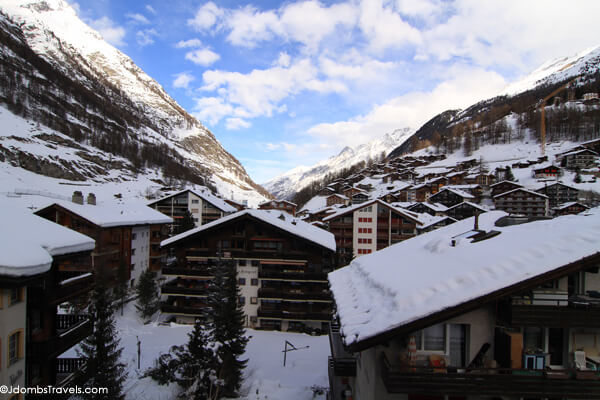
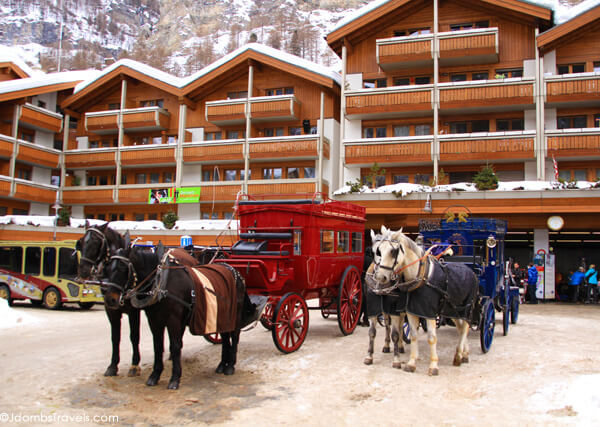
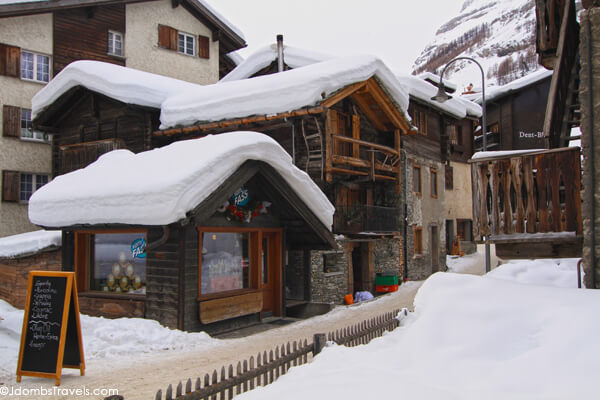
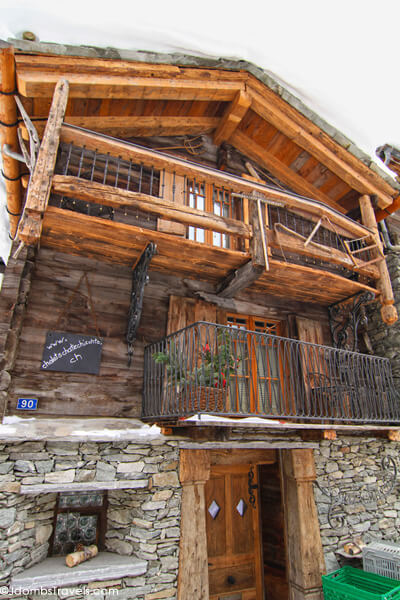
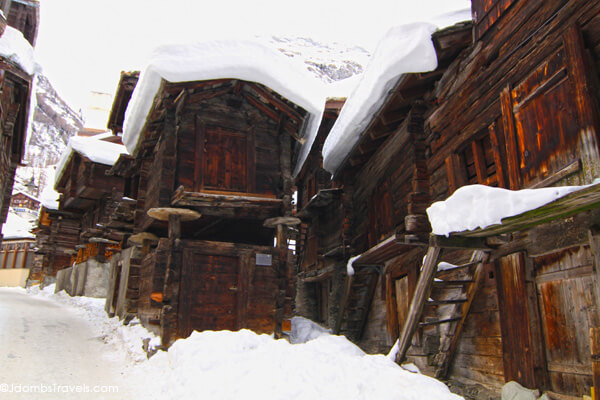
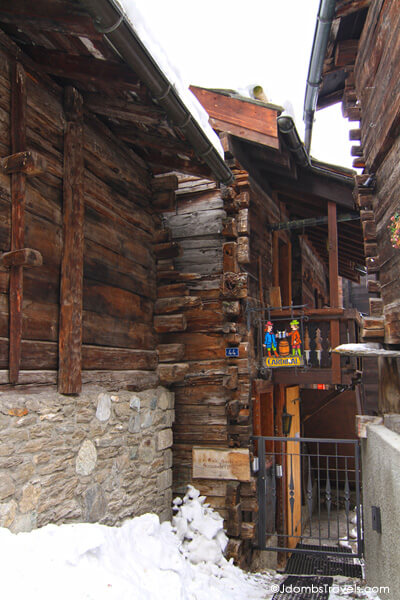
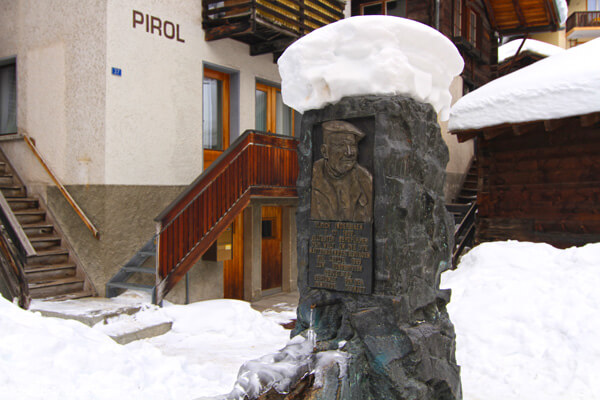
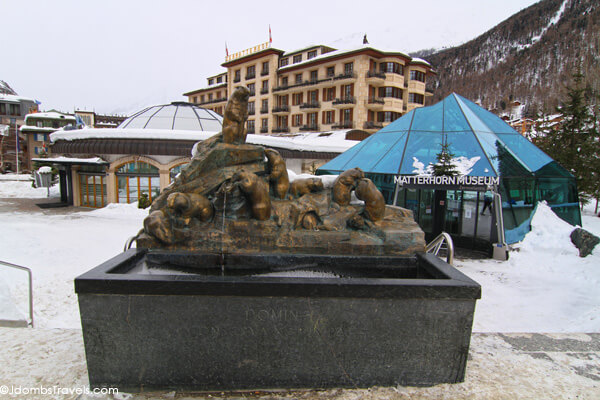


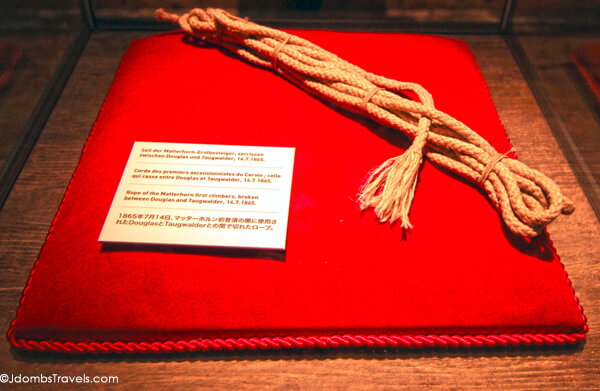
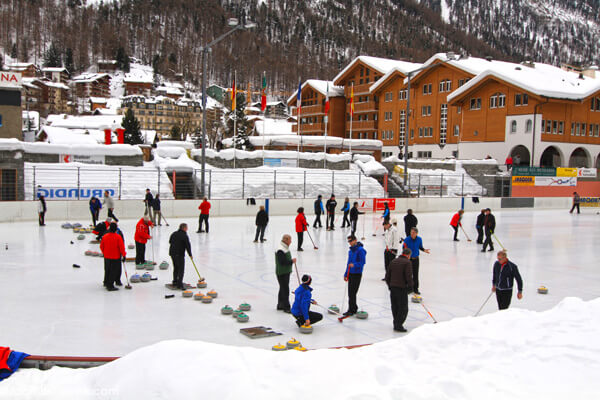
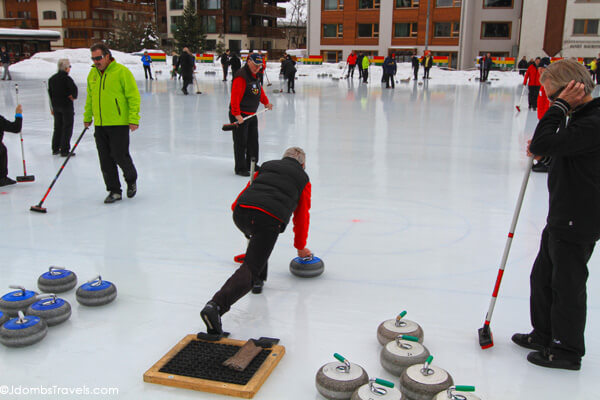
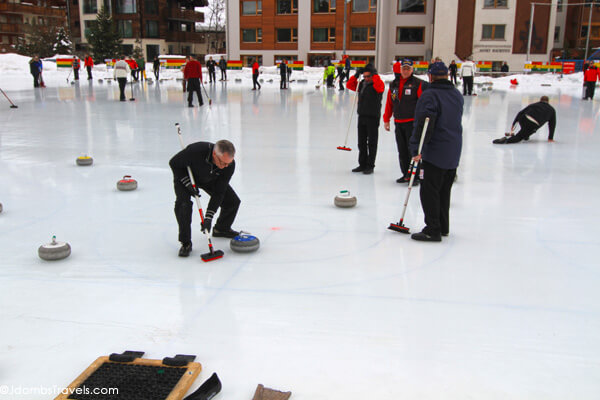
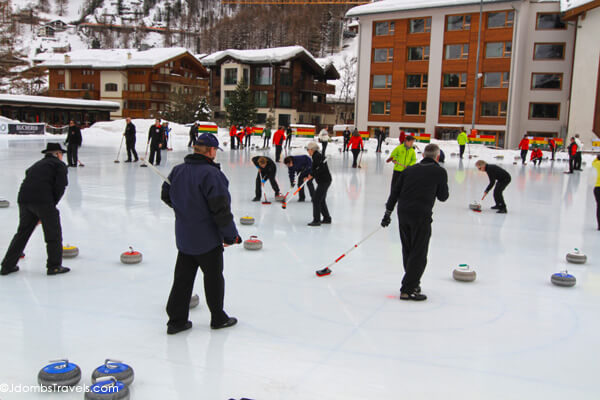

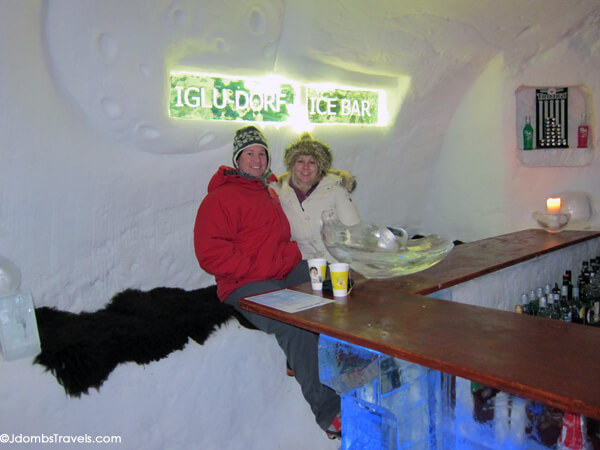
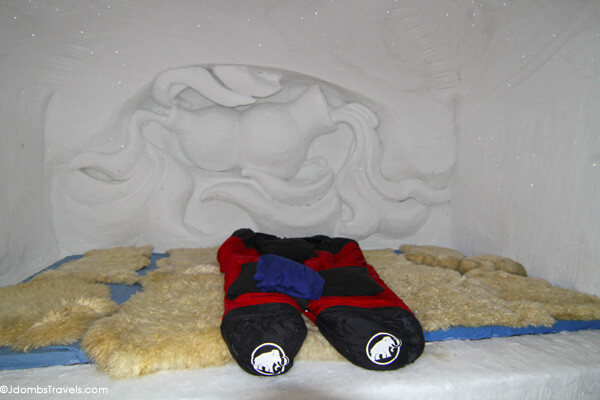
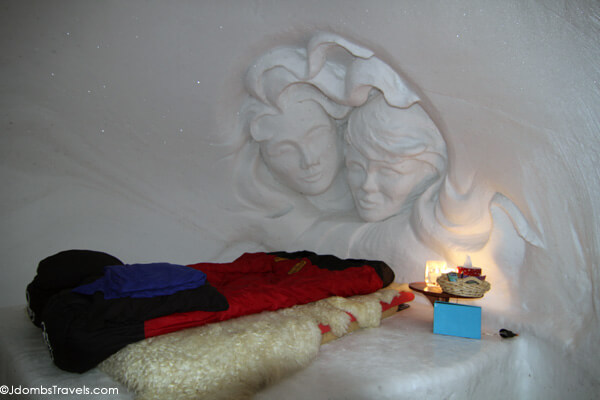


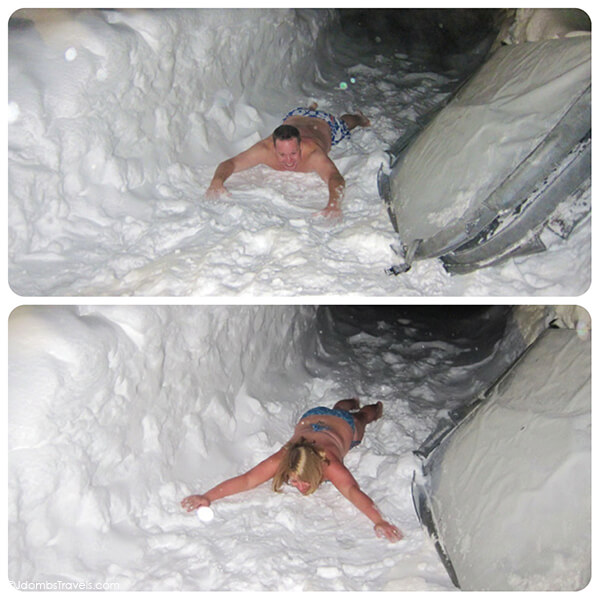
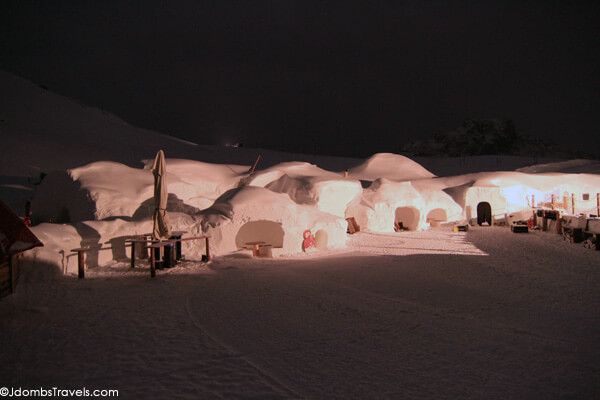
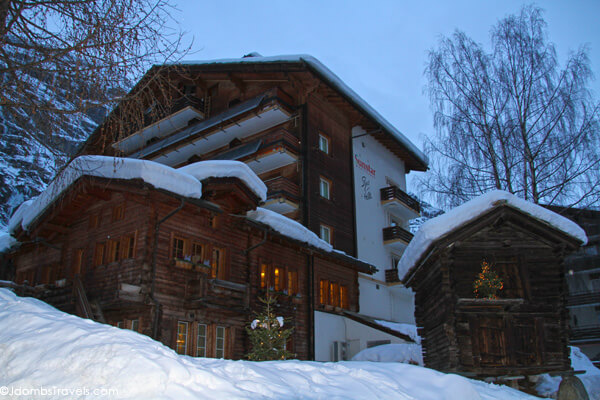

Andi says
Oh it’s soooo beautiful!!!! I wish I was there now in one of those cottages drinking hot chocolate. 🙂
Jennifer Dombrowski says
The village is very beautiful, Andi! An it is lovely to pop into one of the many cafes for a hot chocolate or hot cup of tea.
Kay says
Ahh, this is so good. Thanks for the story and info. Love those snow caps on the roofs of Gädini buildings.
Jennifer Dombrowski says
The Gädini buildings were my favorite too and the way they were snow capped was so beautiful. Like a postcard!
Sharon Bijo says
I’ve been going to Zermatt every year to ski and it’s definitely the gem of the Swiss Alps. Not only does the ski resort have the best slopes I’ve ever seen in the country, but it also has great restaurants, lots of history and culture (like you mentioned) and a lot of activities to do besides skiing. I once went up to the top of a mountain at night for a fondue, and then came down sledding through the darkness with only a flashlight guiding the path. It was an amazing experience — highly recommended.
Jennifer says
That sounds like so much fun, Sharon! What an adventurous way to get back to the village.
Andrew says
This is pretty high on our list being not so far from Freiburg and on Ali’s check off list.
I like the explanation of the double decker houses. The farmhouses from the BlackForest are wider, but similar shaped. The roof sheds the snow nicely. I don’t think the livestock live under the houses, but neat anyway.
Jennifer Dombrowski says
You and Ali should definitely visit Zermatt! We saw many of the Valais style houses on the drive to Tasch and wondered about them. So it was definitely interesting to learn about their heritage.
Sharon says
I’ve been going to Zermatt every year to ski and it’s definitely the gem of the Swiss Alps. Not only does the ski resort have the best slopes I’ve ever seen in the country, but it also has great restaurants, lots of history and culture (like you mentioned) and a lot of activities to do besides skiing. I once went up to the top of a mountain at night for a fondue, and then came down sledding through the darkness with only a flashlight guiding the path. It was an amazing experience — highly recommended.
Shalu Sharma says
The village of Zermatt seems very interesting. The only place I have been to Switzerland is Zurich but hope to visit some other places and the village of Zermatt seems like a place going. These log buildings are amazing to look at. Its amazing how only 40 years ago transport to the Zermatt was mainly by horses.
Jennifer Dombrowski says
We also liked Zurich, but we love the smaller Swiss towns and villages. We’d love to do some hiking in the area and even hike the 40 kilometer long wine road in the Valais region.
Andrea says
How delightful! I love Switzerland and a car-free village sounds charming…
Jennifer Dombrowski says
Most definitely charming, Andrea! Only 5500 people live in the village, so it is very homey feeling and everyone knows everyone.
Lu-Gerda says
Hi, Zermatt is beautiful with the snow everywhere. I loved the village when we visited in the summer of 2011 but I think I must start planning a winter trip to Switzerland.
Jennifer Dombrowski says
Too funny, Lu-gerda! We want to plan a trip back in summer to go hiking around Zermatt.